The Best of Tucson Mountain Biking

Mountain Biking in Tucson
Welcome to Tucson—a Sonoran desert mountain biking mecca!
Tucson means saguaros taller than any tree, trails featuring everything from friendly flow to gnarly jank, and year-round riding that swings from high-alpine chill and forested singletrack on Mount Lemmon to sunblasted rock and gritty desert tech at Starr Pass.
Whether you’re heading to the desert for the first time, just brushing up before 24 Hours in the Old Pueblo, or coming back for another round in Tucson, this post will help you ride smart and thrive in whatever conditions the desert throws at you.
Because Tucson isn’t just another place to spin tires—it’s a proving ground. Ultimately, the desert rewards mountain bikers who pack patience, skill, and humility.
They leave the Old Pueblo a better rider.
For the best rides in Tucson, complete with vetted GPX files of vetted routes across all trail areas—don’t miss the Tucson MTB Ride Guide. If you’re ready to hit saguaros and singletrack, the guide will help make the experience.

Why Tucson for Mountain Biking?
If you like your riding cheesy and spicy, Tucson just might be the chile relleno you’ve been looking for.
Tucson’s Landscape
Tucson doesn’t do “lost in the woods” in the traditional sense. The trails here carve straight through cacti kingdoms where the prickly denizens stand like referees waiting to see if you’ll blow the line.
Climbs open to long desert views, the kind that make you forget your legs are on fire, but you can’t look around too much because the descents serve up everything from rock slabs to loose marbles to more cacti.
The icing on the mountain bike cake? Everything is situated together naturally, framed by not one, but five mountain ranges—some so high that they’re known as Sky Islands—that circle this laid-back city, an amphitheater for your dusty dreams.
Tucson may be dry and dusty (most of the time), but that’s not the whole story. Not even close.
Tucson’s Climate
While the rest of the country is scraping windshields, mountain biking in Tucson is peak season. Winter here isn’t something you “endure”—it’s when you ride with abandon. Blue skies, tacky desert dirt (yes, that’s a thing), and long days daring you to squeeze in just one more mile.
Summer does crank the oven to “broil” and puts the kabash on many a carefree spirit but Mount Lemmon offers any soul an instant alpine escape, and early birds can still get the worm even down low in the desert.
And if you’re around during monsoon season—Tucson’s storied second spring (July to August)—dawn patrol rides come with wildflowers, desert creatures galore, and crunchy dirt.
Tucson’s Culture
Tucson riders are creatures of practicality, fundamentally speaking, but there’s a mighty mountain bike scene.
This is home to 24 Hours in the Old Pueblo, where thousands of riders shred through the desert night under one of the best skies for stargazing on earth.
Local advocates don’t just build and maintain trails—they think big (the Arizona Trail and The Loop).
And when you’re done riding, you’ll eat like a king: Tucson’s food scene runs from James Beard-level fine dining to a taco stand that’ll ruin you for tacos anywhere else.
The overall vibe? Equal parts grit, humor, and laidback desert weirdness.
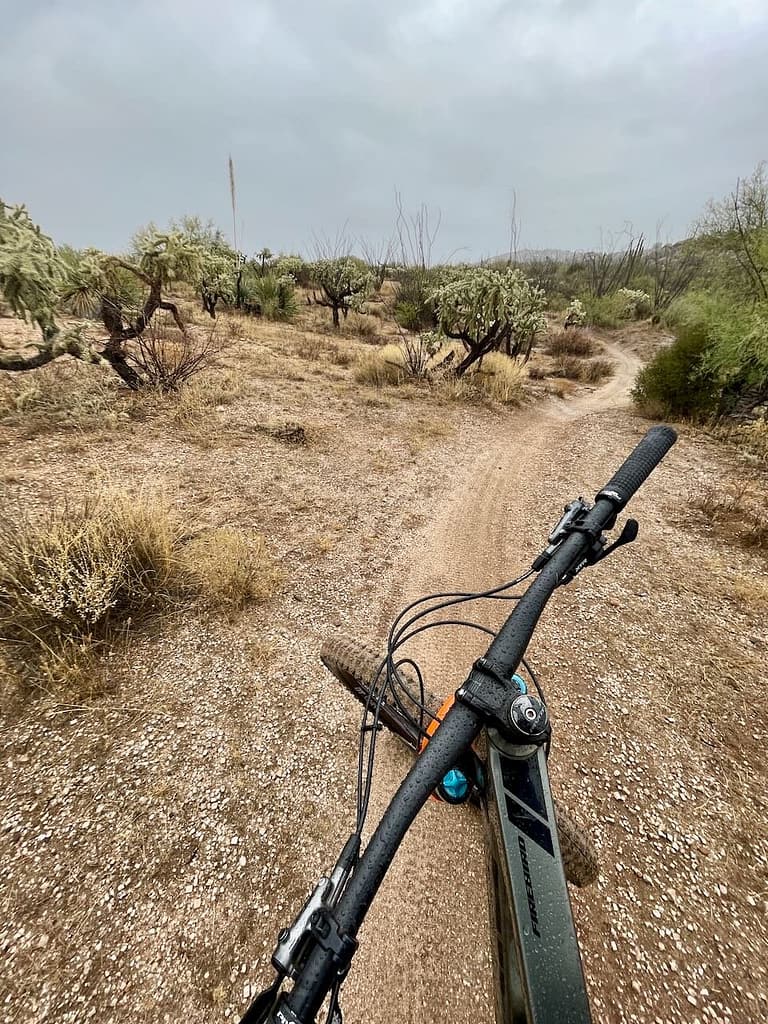
So why mountain bike Tucson? Because the desert here serves up its singletrack like it serves its food—bold, unforgiving, and way better than you expected.
The Many MTB Zones of Tucson
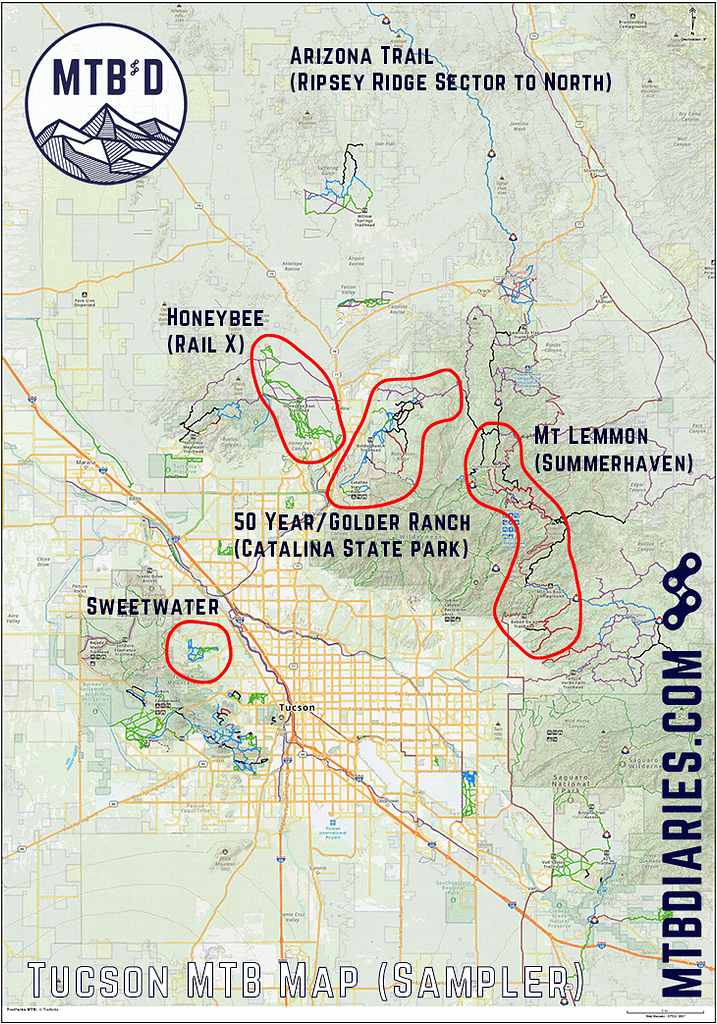
With over 800 miles of trails in the Tucson area, you’re spoiled by choice. But like most places, all trails are not created equal.
One man’s dream is another man’s misery, so choose carefully. The five areas highlighted above showcase a ton of variety, but still leave out some major networks (like Tucson Mountain Park). Check it out:
| Trail Network(s) | What to Expect | Best For |
|---|---|---|
| Honeybee | Miles of smooth desert singletrack with flowy turns and big loop options between the Catalinas and Tortolitas. | Endurance, fast rolling rides, beginners to intermediates. |
| Sweetwater | Approachable climbs and chunky volcanic rock tech near dense saguaros; photogenic and close to downtown. | Beginners, intermediate riders, half-day spins, quick access from town. |
| 50 Year Trail & Golder Ranch | Flow down low but then power climbs, rock rolls, slickrock, and technical desert terrain as you climb up into Coronado National Forest. | Intermediate to advanced riders, mid/long-travel bikes, skill progression. |
| Mount Lemmon | Epic alpine-to-desert descents (Lemmon Drop), mix of forest flow, hike-a-bike, and raw chunk with outrageous views. | Experts, shuttle missions, bragging rights rides (although everyone should go session Prison Camp). |
| AZT Mission & Ripsey Ridge | Remote backcountry Arizona Trail riding with dramatic ridgelines, desert river views, and long point-to-point potential. | Adventure seekers, one-way days, endurance epics. |
The Best MTB Trails of Tucson
With all the variety on hand, what makes a trail “must-ride” depends entirely on what you’re chasing—flow, distance, adrenaline, bragging rights, or just a good story for the post-ride beer.
Our advice? Mix it up. Variety is the spice of life, and when it comes to Tucson mountain biking and trails, it’s a spice you should sprinkle liberally.
But you want specifics, now, right…
Our answer to that is MTBD’s Tucson MTB Trails Cheat Sheet, the quickest rundown around of the best Tucson areas and trails for beginners, intermediate, and advanced mountain bikers. Enter your email and the Tucson MTB Trails Cheat Sheet is delivered as a PDF.
For deep dives on each trail area, specific rides complete with GPX files that you can download and follow, and everything else you need to know about riding Tucson, join our Tucson Ride Guide course.
A Few Example Rides in Tucson
Fast Desert Miles – Honeybee/Rail X Ranch
- Route: Edwin Road (trailhead) → Fenceline → Honeybee East → Honeybee West → Skip the Hill → Honeybee East
- Distance: 10 miles
- Elevation Gain: 524 ft
- Surfaces: 98% trail, 2% dirt road
- Style: Fast desert singletrack, natural flow
You’ll hear lots of references to Honeybee Canyon and there is such a canyon, but don’t expect towering walls on this ride—this is wide-open desert riding. Honeybee/Rail X Ranch is for the mileage junkies and fast movers: miles of buff singletrack that let you keep the throttle open as long as your legs hold.
You’ll pedal between two mountain ranges—the Catalinas on one side, the Tortolitas on the other—with endless ribbons of trail linking together into loops as big as you want. Keep it tight with this 10-mile sampler in the center of the network, or stitch it into a 30+ mile desert epic.
(Pro Tip: If you climb higher into the Tortolitas, an area known as Tortolita Mountain Park, you’ll find a whole different flavor of riding.)
Slightly Chunkier – Sweetwater
- Route: Sweetwater Preserve (trailhead) → Lost Arrow → Homestead → Redtail Ridge → Nighthawk → Desperado (N)
- Distance: 7 miles
- Elevation Gain: 421 ft
- Surfaces: 100% trail
- Style: Varied desert singletrack, volcanic rock features, built flow
Want a taste of rocks without full-on gnarl? This ride pairs the Sweetwater Preserve’s approachable climbs with the Tucson Mountain’s volcanic terrain—something of a rarity in the basin. It’s just technical enough to keep you honest, without punishing mistakes.
Add in dense stands of saguaros and killer desert views (points of interest in the Ride Guide) just minutes from downtown, and you’ve got one of the most photogenic, uniquely Tucson rides on the list.
You’ll finish with desert flow on Desperado, too.
For Punch – 50 Year Trail & Golder Ranch
- Route: Golder Ranch (trailhead) → North Equestrian → 50 Year → The Chutes → Chutes Acc 2 → Upper Fifty Year → Slab City → Upper 50 Year → 50-Year Slabs → Middle Gate → 50 Year → Golder Ranch Road
- Distance: 12 miles
- Elevation Gain: 1,098 ft
- Surfaces: 98% trail, 2% access (dirt road)
- Style: Tech flow and slabs, progression ride
Looking to turn things up? The 50 Year area (Catalina State Park, 50 Year aka Golder Ranch) delivers. From the bobsled berms of The Chutes to the granite playgrounds of Slab City and 50 Year Slabs, this loop builds in intensity as you climb higher into Coronado National Forest and/or hit the B lines.
Expect a little of everything—flow, chunk, slickrock, and route-finding challenges that reward commitment. No trail signs out here. It’s the kind of ride where mid-travel bikes shine, skills sharpen, and finishing feels like an accomplishment (and may stir a deep desire to go back, because now you know the lines).
Scouting/sessioning is recommended as some of the bigger features can be consequential.
Dive deeper into the 50 Year Trail and Golder Ranch network with our detailed guide, including sample routes, tips, and what to expect on the trails: 50 Year & Golder Ranch Mountain Biking Guide.
Bragging Rights – Mount Lemmon
- Route: Aspen Meadow (trailhead) → Aspen Draw → Sunset Trail → Bigelow → Incinerator Ridge → Green Mountain → Bug Springs → Molino Basin → Bellota → La Milagrosa
- Distance: 31 miles
- Elevation Gain: 3,652 ft
- Elevation Loss: 9,953 ft
- Style: Gnar, tech, suffer-fest descents with a side of hike-a-bike
The Lemmon Drop is Tucson’s crown jewel—nearly 10,000 feet of descending down Mt. Lemmon stitched together from alpine singletrack, exposed ridgelines, and desert gnar. It’s a rite of passage, the kind of ride you tell stories about long after your hands stop cramping from braking.
But it doesn’t have to be all-or-nothing. You can break this beast down into bite-size missions and, depending on the seasons and conditions, you probably should:
- Prison Camp (Molino) → approachable and grin-inducing
- Bug Springs → spicy mix of tech and hike-a-bike
- Incinerator Ridge → exposed, committing, not for the faint of heart
Expect changing ecosystems as you drop, and climb, and drop—from pine forest to cactus-studded desert. And don’t skip the pullout and taking a quick walk out to the edge at Windy Point whether headed up or down: world-class views and an unreal perspective on what you’re riding today.
Wildcard Big Ride – Ripsey Ridge (AZT)
- Route: Freeman Road/Arizona Trail (trailhead) → South Tortilla Mountains → Powerline → Tortilla Mountains (Boulders) → Tortilla Mountains (Power Line) → Cougar Hill → Tortilla Trail → Tortilla Mountains (Ripsey) → Jeep Connector → North Tortilla Mountains (Kelvin TH to Gila River)
- Distance: 28 miles
- Elevation Gain: 1,643 ft
- Elevation Loss: 3,894 ft
- Surfaces: 91% trail, 9% access (jeep road)
- Style: Remote, big miles, unforgettable ridgeline payoff
The Arizona Trail offers many flavors, but Ripsey Ridge is a too-often forgotten favorite: a sinuous spine of singletrack that rolls, drops, and dances high above the desert floor. Get a drop off and a pick-up, and you’re in for a point-to-point epic with reasonable climbing for maximum payoff.
This is remote country, so load up on water, snacks, and self-sufficiency. There’s no easy bail-out—just you, the trail, and miles of views across the Gila River Valley.
The ride finishes on the riverbank, a perfect spot to crack something cold, soak the dust off, and bask in the glow of a day well spent. Bonus points if you pre-ordered a pizza to meet you in Kelvin—because yes, that’s how desert dwellers do it.
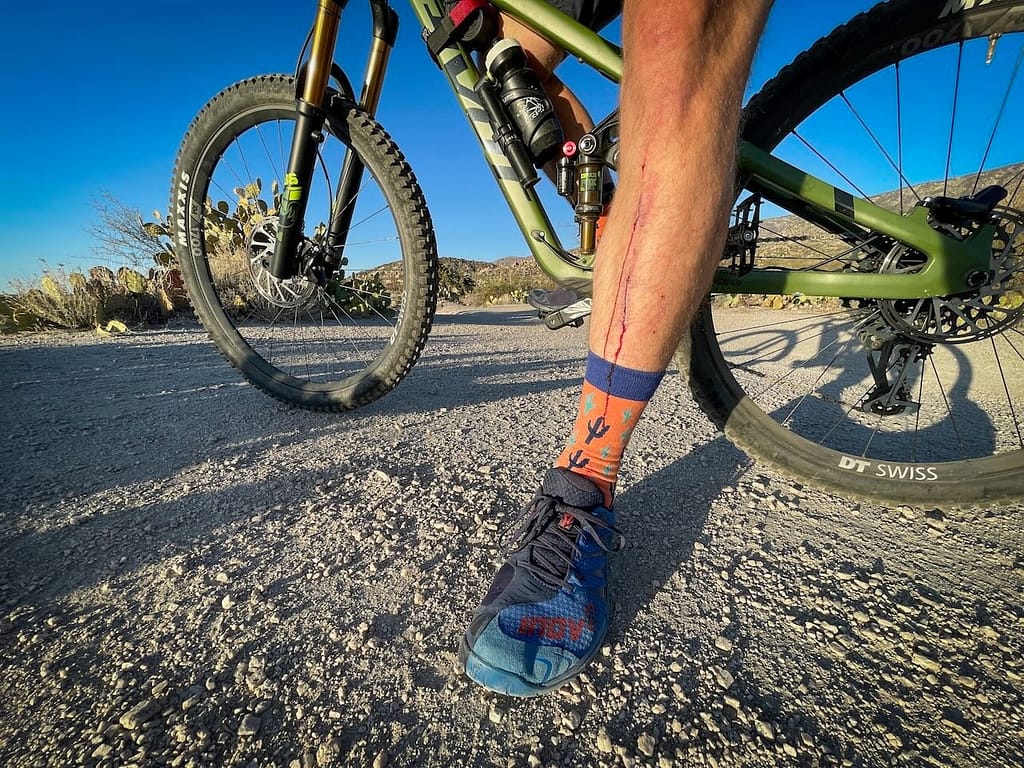
Gear, Packing, and Desert Survival for Tucson
You’re coming to the desert—might as well look like a stormtrooper, minus the Imperial agenda.
Tucson mountain biking calls for sleeves, shades, and enough gear to survive cactus slaps, baby-head descents, and the occasional rogue roadrunner. Here’s how to ride smart, stay sane, and actually enjoy yourself.
Clothing
Long sleeves. Counterintuitive? Maybe. But they save your arms from cactus spines, cholla pokes, and that desert sun that will turn you into a walking tomato. Bonus: you look mysterious and menacing, except… your helmet is tilted.
Bike
All-rounder trail bike is ideal—something that can tackle the mix Tucson will throw at you. Die-hard XC or gravity-only types, fine, stick to your guns.
Tires & Tubes
Fast rolling in the back (with some side knobs), chunkier up front. Before your first ride: fresh fill of Stans or equivalent, plug kit, patch kit, spare tube, all the goodies. Tucson flat tire gods are always looking to punish the unprepared.
Suspension
Check or overhaul your fork, and shock, before the trip. Well before the trip–this is not a last-minute checkbox. You’ll appreciate buttery smooth performance more than ever, versus an accidental pogo party across rocky desert trails.
Shoes & Pedals
Scramble-friendly shoes + flats = can’t go too wrong.
Clipless? Yes, if you’re skilled in that department. Going flat-soled clipless shoes and clipless pedals with cages checks all the boxes—pedal all day, scramble when needed.
Because the best views are from the top of the rocks (as always).
Glasses
Big, reflective shades. Protection from sun, dust, and a mirror to check out your amazing post-ride hair.
Don’t forget the micro-cloth to clean off the partially-evaporated stream of sweat that will inevitably mar the dead center of your massive lens 15 minutes into the ride.
Bonus: instant desert-pro vibes.
Lights
One big bright handlebar light unlocks morning and evening rides. Summer, shoulder season, or just a late-night craving for singletrack—do it.
Hydration & Survival
Water systems—yes. Comb & tweezers for cactus spine removal, yes. Nice-to-haves: insulated water bottle, dry chain lube, and… wait for it…
Search-and-Rescue Insurance
Because the desert doesn’t negotiate, and if you’re in a tough spot you should call for help without a second thought.
Are we getting too dramatic? I mean—we said survival, after all…
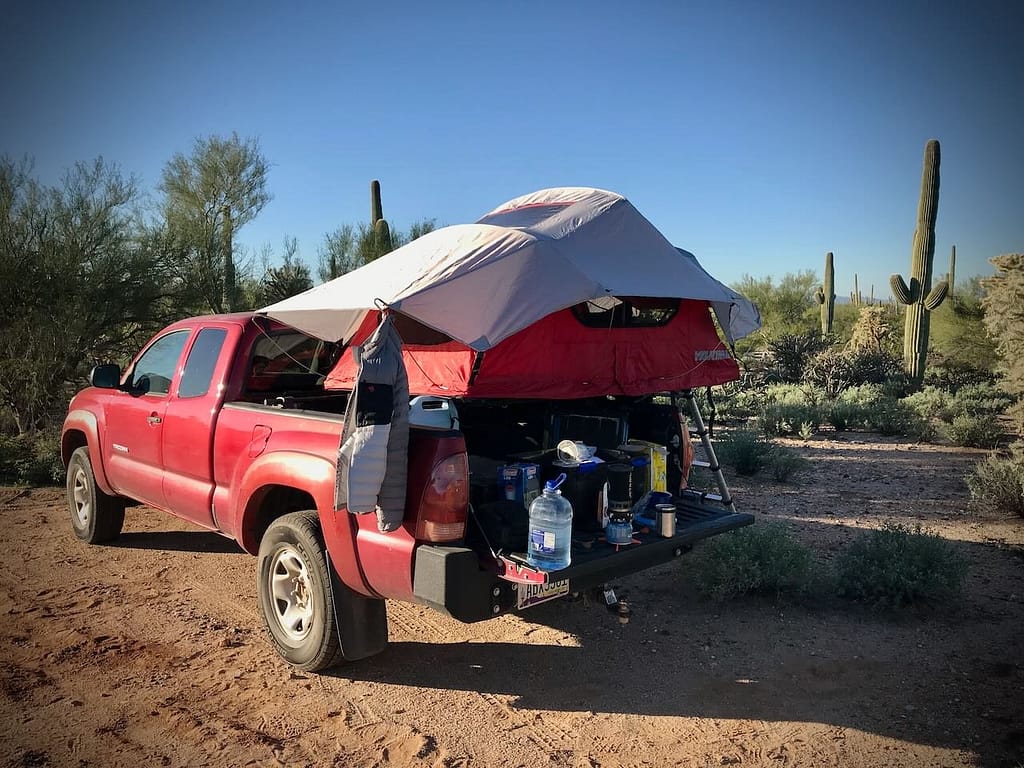
Where to Stay, Eat, and Recover in Tucson
Stay
Tucson has accommodations for mountain bikers as varied as its trails. Want city energy after your ride? Downtown hotels or near the University of Arizona put you close to food, nightlife, and culture.
Need quiet and quick trail access? Oro Valley AirBnBs are perfect for easy mornings and laid-back evenings.
Gravity junkie? Base-of-Mt. Lemmon rentals put you on the doorstep of epic descents.
Prefer luxe with a side of relaxation? JW Marriott Tucson Starr Pass Resort and Spa offers pools, a lazy river, and trails out back, while Miraval Arizona puts you literally on the doorstep of the 50 Year Trails for full-on spa + pedal indulgence.
Mix and match depending on your style, or just plan to experience them all on a long weekend—you earned it.
Eat
Tucson isn’t just a mountain biking mecca—it’s a UNESCO City of Gastronomy, which means the food scene here is kinda a big deal. After a long ride, your stomach deserves a reward as epic as the trails.
For classic Sonoran flavor, grab a chile relleno (or three) at El Charro Café, the oldest Mexican restaurant north of the border—order early or risk a line that rivals a singletrack bottleneck.
If you’re after inventive Southwest dishes with a modern twist, Penca delivers the goods. Looking for casual bites after a dusty morning? Seis Kitchen keeps it fresh, fast, and utterly satisfying.
And for the full foodie experience, The Coronet offers farm-to-table delights in a charming historic spot, perfect for winding down after a day of riding.
From taco stands to fine dining, Tucson proves you can chase epic descents by day and epic meals by night. Mix it up depending on your vibe—or just follow your nose.
Recover
Riding Tucson’s trails is one thing—recovering like a pro is another. After hammering climbs on Lemmon or grinding through desert tech on Starr Pass, you’re going to want to treat your body (and your spirit). Luckily, Tucson has plenty of ways to recharge.
For culture and low-impact adventure, wander among native wildlife at the Sonoran Desert Museum, or climb a nearby peak for some stargazing with telescopes that make the Milky Way feel within arm’s reach.
Downtown and the University of Arizona are connected by a convenient streetcar, making hopping between 4th Avenue’s nightlife, local patios, and galleries a breeze after a long day on the dirt.
Pamper yourself: Tucson has plenty of spas beyond the resorts—think boutique day spas, wellness centers, and hot-stone massage spots ready to knead out every climb, turn, and tech section you rode that day.
Fuel up smart: Stretch in the desert air, hydrate, and snack strategically—because Tucson’s trails are generous, but they reward those who come back refreshed.
Recovery isn’t just about easing muscles; it’s about refueling for the next adventure. That could mean exploring southern Arizona’s wine country, poking around historic mining towns, or visiting wildlife reserves for a little slow-motion desert therapy.
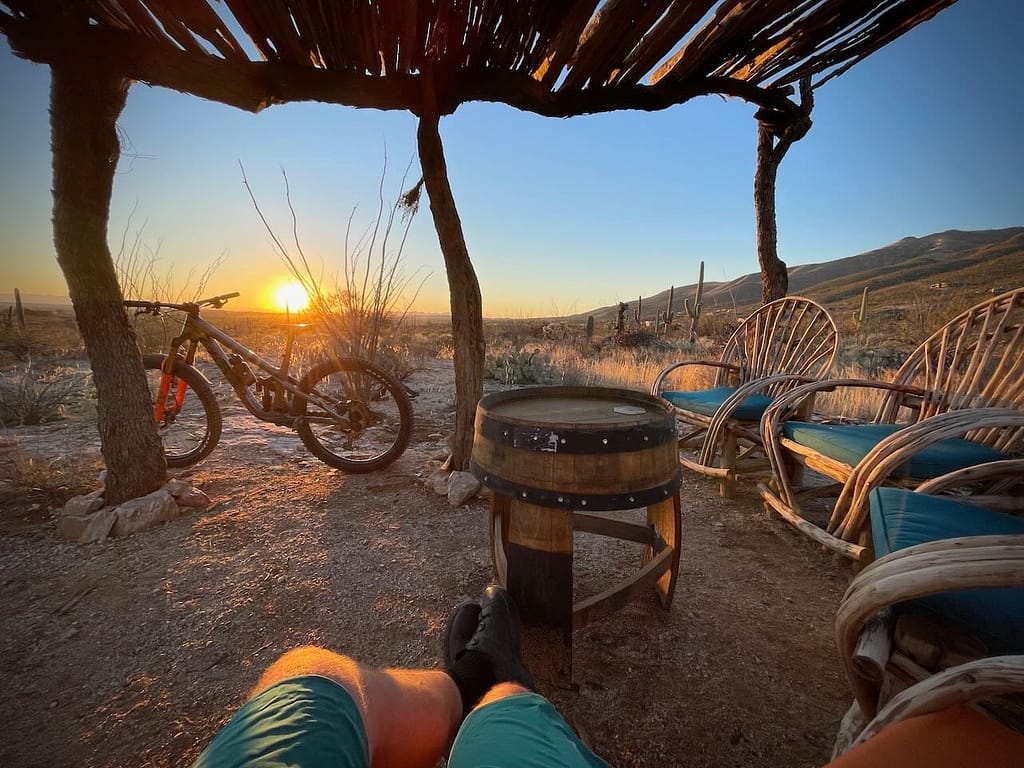
The Wrap-Up for Tucson
So—why Tucson for mountain biking? Because it’s not just a place you ride. It’s a place that can change the way you think about riding.
You come for the trails—the desert singletrack that makes you forget everything. You stay for the vibe—the food, the music, the saguaros standing around like silent spectators to your sketchy line choices.
And when you leave? You don’t just leave with tired legs—you hopefully leave with a sense of place. And the memory of the time you pulled a cactus out of your shin with tweezers and decided that the vegetation back home has a lot going for it.
Tucson is tough, yes. Humbling, often. But it’s also truly unique—the second your tires hit Sonoran dirt you’ll know you’ve found something just a little bit different. At that point just be sure to make the most of it!
If you’re planning a trip—or even just daydreaming about it—don’t stop here. Because the desert doesn’t hand out freebies, but if you show up decently prepared, it’ll give you the ride of your life.
Tucson Mountain Biking FAQ
Is Tucson good for mountain biking?
Absolutely. Tucson is a desert city wrapped in trails. From the right spot you can look out across the landscape and point to where flowy desert singletrack, chunky volcanic ridges, and high-elevation alpine can be found. You won’t run out of variety — you’ll run out of legs first.
What’s the best time of year to mountain bike in Tucson?
Fall through spring (October to April) is prime. Tucson is known as a winter training mecca for pro and amateur endurance athletes — because it’s an amazing place to be outside when elsewhere it is more amazing to be inside.
Where are the best trails for beginners in Tucson?
Sweetwater and Fantasy Island, because both have mellow singletrack and are relatively small, compact, trail networks. Then, Honeybee (from Big Wash trailhead), which has lots of mellow singletrack but you can get way out there. Tortolita Mountain Preserve is also a great beginner loop or place to get an initial taste for desert riding.
What’s the most famous/epic ride in Tucson?
The crown goes to the Lemmon Drop — nearly 10,000 feet of descending from alpine forest into cactus country. It’s a long, technical, gnarfest with a healthy amount of jank climbing thrown in for good measure, so don’t count on gravity alone to get you down.
Do I need a full-suspension bike in Tucson?
If you want to sample more than the mellow, desert-floor trails, full suspension is recommended. That said, there are nearly infinite miles of (relatively) smooth singletrack, and there’s also the Loop. So there’s plenty of fun to be had on a hardtail or (gasp) fully rigid steed.
Can I rent a mountain bike in Tucson?
Yes. Multiple shops rent quality bikes — from brands you want to ride (Santa Cruz, Specialized, Pivot, etc.). Book ahead in peak season.
Are there mountain bike tours or shuttles in Tucson?
Yep. Local operators offer guiding you through trail networks. You’ll need a shuttle for big rides like the Lemmon Drop or certain AZT sections — commercial options are available in Tucson.
Is Tucson mountain biking dangerous?
No more than anywhere else — if you ride smart. The Sonoran desert does add a few twists: bring more water than you think, respect cacti and the creatures, and don’t underestimate how remote some trails feel.
Where should I stay for easy trail access?
Oro Valley or Catalina puts you near Honeybee and the 50 Year Trail, with a more suburban/rural feel. West Tucson has Starr Pass and Sweetwater, and is close to downtown and the university district — Tucson’s best offering of restaurants and nightlife.
What’s unique about Tucson mountain biking?
It’s the contrast. One hour you’re riding in a forest with pine needles under tire, and later that day you’re railing through saguaros. Plus, the community is welcoming and the Mexican food is legit.
Before You Go
Download MTBD’s free Tucson MTB Trails Cheat Sheet. Just enough to get you rolling!
Last Updated: 2 November 2025



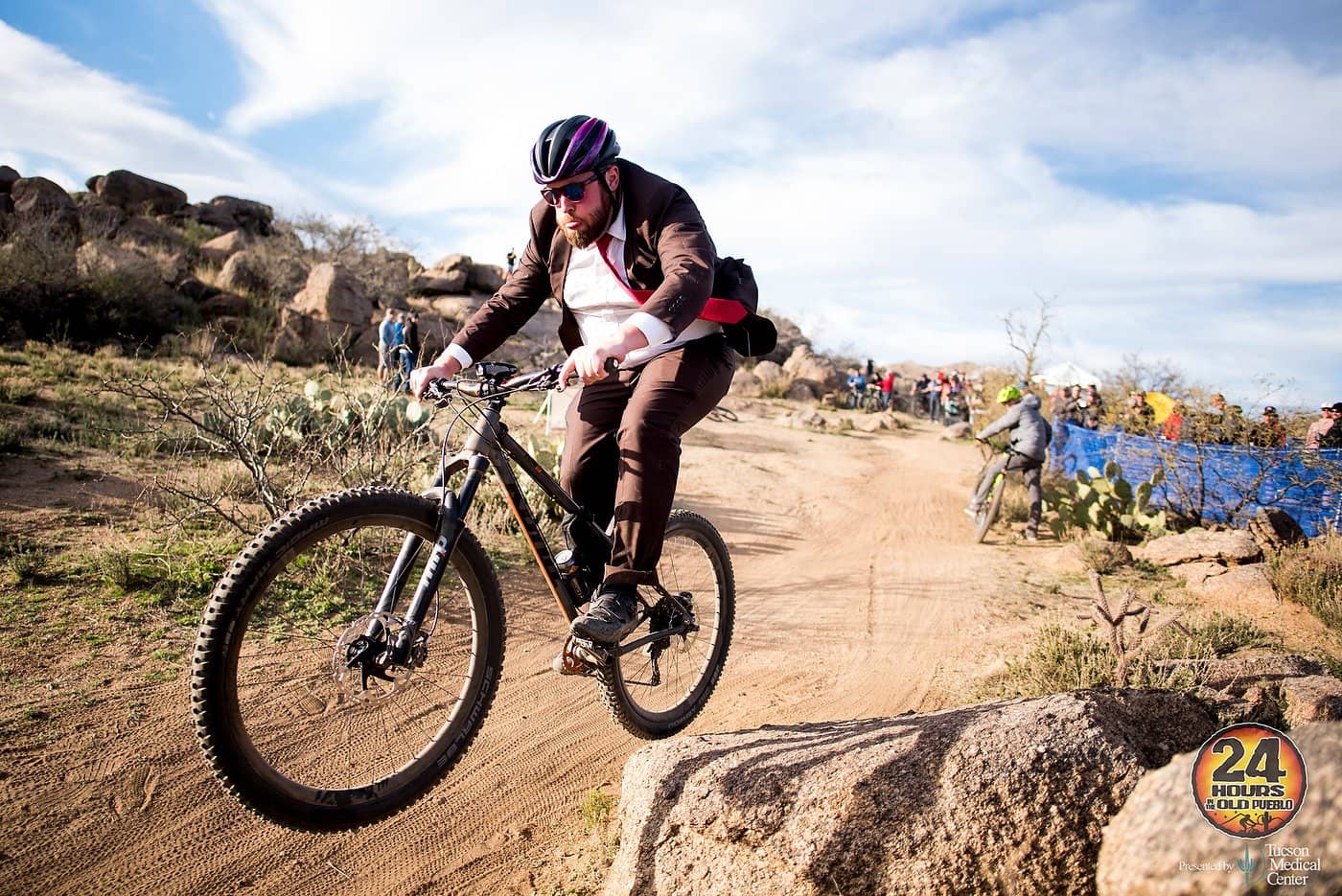
4 Comments
Comments are closed.